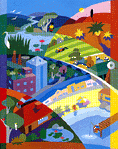
In the Backyard and Beyond


In the Backyard and Beyond

| Some of Australia's most biodiverse areas survive
around urban centres. For example, there is rich biodiversity in the sandstone country and
smooth barked apple forests north of Sydney, NSW, and in the rainforests of the Border
Ranges near Brisbane, Queensland. One hundred bush regeneration groups now work in Sydney,
with 12 in Brisbane and similar numbers in Canberra (ACT) and Melbourne (Victoria). In
Perth, volunteers at the Kings park and Botanic Gardens have restored bushland nearby.
Researchers at the gardens have provided information to help restore native vegetation in
the Mt Eliza escarpment and the Jarrah and Tuart forests. There are several major threats to urban biodiversity. Land clearing of course has a substantial impact, as do nutrients. Australia's plant life has adapted to out continent's ancient, low-nutrient soils. When urban bushland is invaded by detergents, sewage overflows and stormwater, these chemicals act as a fertiliser, encouraging weeds to run rampant and suffocate native plants. If you don't have a garden: This section of my environment web site is based upon a booklet produced by the Department of the Environment and Heritage, Environment Australia. This material can be freely reproduced for non-commercial purposes provided Environment Australia is acknowledged. Their logo appears at the bottom of this page. |
Now take a tour of my Biodiversity Web.
![]() 20 Ways to Protect Biodiversity
20 Ways to Protect Biodiversity
![]() Food, Health, Farms
Food, Health, Farms
![]() On Holiday and
on the Water
On Holiday and
on the Water
![]() Warning: Signs of Change
Warning: Signs of Change
![]() Links and Resources
Links and Resources
![]() Biodiversity Home Page
Biodiversity Home Page
![]() Back to the Environment Site Map
Back to the Environment Site Map
![]() E-mail me
E-mail me
Biodiversity material from:
